Free NCERT Solutions for Class 12 Maths Chapter 5 Continuity and Differentiability solved by Expert Teachers as per NCERT (CBSE) Book guidelines and brought to you by CBSE Learning. These Continuity and Differentiability Exercise Questions with Solutions for Class 12 Maths covers all questions of Chapter Continuity and Differentiability Class 12 and help you to revise complete Syllabus and Score More marks as per CBSE Board guidelines from the latest NCERT book for class 12 maths. You can read and download NCERT Book Solution to get a better understanding of all topics and concepts
5.1 Introduction
5.2 Continuity
5.2.1 Algebra of continuous functions
5.3. Differentiability
5.3.1 Derivatives of composite functions
5.3.2 Derivatives of implicit functions
5.3.3 Derivatives of inverse trigonometric functions
5.4 Exponential and Logarithmic Functions
5.5. Logarithmic Differentiation
5.6 Derivatives of Functions in Parametric Forms
5.7 Second Order Derivative
5.8 Mean Value Theorem.
Continuity and Differentiability NCERT Solutions – Class 12 Maths
Exercise 5.1 : Solutions of Questions on Page Number : 159
Q1 :Prove that the function![]() is continuous at
is continuous at![]()
Answer :

Therefore, f is continuous at x= 0

Therefore, f is continuous at x= – 3

Therefore, f is continuous at x= 5
Q2 :Examine the continuity of the function![]() .
.
Answer :
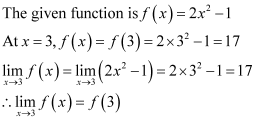
Thus, f is continuous at x= 3
Q3 :Examine the following functions for continuity.
(a) ![]()
(b)![]()
(c)![]()
(d)![]()
Answer :
(a) The given function is![]()
It is evident that fis defined at every real number kand its value at k is k – 5.
It is also observed that,![]()
![]()
Hence, f is continuous at every real number and therefore, it is a continuous function.
(b) The given function is![]()
For any real number k≠ 5,
we obtain
Hence, f is continuous at every point in the domain of fand therefore, it is a continuous function.
(c) The given function is![]()
For any real number c≠ – 5, we obtain
Hence, f is continuous at every point in the domain of fand therefore, it is a continuous function.
(d) The given function is![]()
This function fis defined at all points of the real line.
Let cbe a point on a real line. Then, c< 5 or c= 5 or c > 5
Case I: c< 5
Then, f (c) = 5 – c 
Therefore, fis continuous at all real numbers less than 5.
Case II :
c= 5
Then,![]()
![]()

Therefore, f is continuous at x= 5
Case III: c> 5

![]()
Q4 :Prove that the function ![]() is continuous at x= n, where n is a positive integer.
is continuous at x= n, where n is a positive integer.
Answer :
The given function is f(x) = xn
It is evident that fis defined at all positive integers, n, and its value at n is nn.![]()
![]()
Therefore, f is continuous at n, where n is a positive integer.
Q5 :Is the function fdefined by![]()
continuous at x= 0? At x= 1? At x= 2?
Answer :
The given function f is![]()
At x= 0,
It is evident thatf is defined at 0 and its value at 0 is 0.![]()
![]()
Therefore, f is continuous at x= 0
At x = 1,
f is defined at 1 and its value at 1 is 1.
The left hand limit of f at x = 1 is,![]()
The right hand limit of f at x = 1 is,
Therefore,f is not continuous at x= 1
At x = 2,
f is defined at 2 and its value at 2 is 5.
![]()
![]()
Q6 :Find all points of discontinuity of f, where f is defined by![]()
Answer :
The given function fis![]()
It is evident that the given function fis defined at all the points of the real line.
Let c be a point on the real line. Then, three cases arise.
(i) c< 2 (ii) c> 2
(iii) c= 2
Case (i) c< 2
Therefore, f is continuous at all points x, such that x< 2
Case (ii) c> 2
![]()
Therefore, f is continuous at all points x, such that x> 2
Case (iii) c= 2
![]()
Then, the left hand limit of f atx = 2 is,
The right hand limit of fat x = 2 is,
![]()
It is observed that the left and right hand limit of fat x = 2 do not coincide.
Therefore, f is not continuous at x= 2
Hence, x = 2 is the only point of discontinuity of f.
Q7 :Find all points of discontinuity of f, where f is defined by

Answer :
The given function f is
The given function f is defined at all the points of the real line.
Let c be a point on the real line.
Case I:

Therefore, f is continuous at all points x, such that x< – 3
Case II:
![]()

Therefore, f is continuous at x= – 3
Case III:
![]()
![]()
Therefore, f is continuous in ( – 3, 3).
Case IV: If c= 3, then the left hand limit of f atx = 3 is,![]()
The right hand limit of f atx = 3 is,![]()
It is observed that the left and right hand limit of fat x = 3 do not coincide. Therefore, f is not continuous at x= 3
Case V: 
Therefore, f is continuous at all points x, such that x> 3
Hence, x = 3 is the only point of discontinuity of f.
Q8 :Find all points of discontinuity of f, where f is defined by

Answer :
The given function f is
It is known that,![]()
Therefore, the given function can be rewritten as

The given function fis defined at all the points of the real line.
Let c be a point on the real line.
Case I:

Therefore, f is continuous at all points x< 0
Case II:
If c= 0, then the left hand limit of f at x = 0 is,
![]()
The right hand limit of f at x = 0 is,
![]()
It is observed that the left and right hand limit of fat x = 0 do not coincide. Therefore, f is not continuous at x= 0
Case III:

Therefore, f is continuous at all points x, such that x> 0
Hence, x = 0 is the only point of discontinuity of f.
Q9 :Find all points of discontinuity of f, where f is defined by

Answer :
The given function fis

It is known that,![]()
Therefore, the given function can be rewritten as

Let c be any real number. Then,
![]()
Also,![]()
Therefore, the given function is a continuous function.
Hence, the given function has no point of discontinuity.
Q10 :Find all points of discontinuity of f, where f is defined by
 Answer :
Answer :
The given function fis

The given function fis defined at all the points of the real line.
Let c be a point on the real line.
Case I:

Therefore, f is continuous at all points x, such that x< 1
Case II:
![]()
The left hand limit of f atx = 1 is,
![]()
The right hand limit of f atx = 1 is,

Therefore, f is continuous at x= 1
Case III:

![]()
Therefore, f is continuous at all points x, such that x> 1
Hence,the given function f has no point of discontinuity.
Q11 : Find all points of discontinuity of f, where f is defined by

Answer :
The given function fis
The given function fis defined at all the points of the real line.
Let c be a point on the real line.
Case I:
![]()
![]()
Therefore, f is continuous at all points x, such that x< 2
Case II:
![]()

Therefore, f is continuous at x= 2
Case III:
 Therefore, f is continuous at all points x, such that x> 2
Therefore, f is continuous at all points x, such that x> 2
Thus, the given function fis continuous at every point on the real line.
Hence, f has no point of discontinuity.
Q12 : Find all points of discontinuity of f, where f is defined by

Answer :
The given function fis
The given function fis defined at all the points of the real line.
Let c be a point on the real line.
Case I:

Therefore, f is continuous at all points x, such that x< 1
Case II:
If c= 1, then the left hand limit of fat x = 1 is,
![]()
The right hand limit of fat x = 1 is,
![]()
It is observed that the left and right hand limit of fat x = 1 do not coincide. Therefore, f is not continuous at x= 1
Case III:

![]()
Therefore, f is continuous at all points x, such that x> 1
Thus, from the above observation, it can be concluded that x= 1 is the only point of discontinuity of f.
Q13 : Is the function defined by
![]()
a continuous function?
Answer :
The given function is
![]()
The given function fis defined at all the points of the real line.
Let c be a point on the real line.
Case I:
![]()
![]()
Therefore, f is continuous at all points x, such that x< 1
Case II:
![]()
The left hand limit of f at x = 1 is,
![]()
The right hand limit of fat x = 1 is,
![]()
It is observed that the left and right hand limit of fat x = 1 do not coincide. Therefore, f is not continuous at x= 1
Case III:
![]()
![]()
Therefore, f is continuous at all points x, such that x> 1
Thus, from the above observation, it can be concluded that x= 1 is the only point of discontinuity of f.
Q14 : Discuss the continuity of the function f, where f is defined by
 Answer :
Answer :
The given function is
The given function is defined at all points of the interval [0, 10].
Let c be a point in the interval [0, 10].
Case I:

Therefore, f is continuous in the interval [0, 1).
Case II:
![]()
The left hand limit of f at x = 1 is,
![]()
The right hand limit of fat x = 1 is,
![]()
It is observed that the left and right hand limits of f at x= 1 do not coincide.
Therefore, f is not continuous at x= 1
Case III:

Therefore, f is continuous at all points of the interval (1, 3).
Case IV:
![]()
The left hand limit of f at x = 3 is,
![]()
The right hand limit of fat x = 3 is,
![]()
It is observed that the left and right hand limits of f at x= 3 do not coincide.
Therefore, f is not continuous at x= 3
Case V:
![]()
![]() Therefore, f is continuous at all points of the interval (3, 10].
Therefore, f is continuous at all points of the interval (3, 10].
Hence, f is not continuous at x = 1 and x = 3
Q15 :Discuss the continuity of the function f, where f is defined by
Answer :
The given function is
The given function is defined at all points of the real line.
Let c be a point on the real line.
Case I:

Therefore, f is continuous at all points x, such that x < 0
Case II:
![]()
The left hand limit of f at x= 0 is,
![]() The right hand limit of fat x = 0 is,
The right hand limit of fat x = 0 is,

Therefore, f is continuous at x= 0
Case III:

Therefore, f is continuous at all points of the interval (0, 1).
Case IV:
![]()
The left hand limit of f at x = 1 is,
![]() The right hand limit of fat x = 1 is,
The right hand limit of fat x = 1 is,
![]() It is observed that the left and right hand limits of f at x= 1 do not coincide. Therefore, f is not continuous at x= 1
It is observed that the left and right hand limits of f at x= 1 do not coincide. Therefore, f is not continuous at x= 1
Case V:

Therefore, f is continuous at all points x, such that x> 1
Hence, f is not continuous only at x = 1
Q16 :Discuss the continuity of the function f, where f is defined by
Answer :
The given function fis
The given function is defined at all points of the real line.
Let c be a point on the real line.
Case I:

Therefore, f is continuous at all points x, such that x < – 1
Case II:
![]()
The left hand limit of f at x = – 1 is,
![]()
The right hand limit of fat x = – 1 is,
![]()
![]()
Therefore, f is continuous at x= – 1
Case III:

Therefore, f is continuous at all points of the interval ( – 1, 1).
Case IV:
![]()
The left hand limit of f at x = 1 is,
![]()
The right hand limit of fat x = 1 is,
![]()
![]()
Therefore, f is continuous at x= 2
Case V:
![]()
![]()
Therefore, f is continuous at all points x, such that x> 1
Thus, from the above observations, it can be concluded that f is continuous at all points of the real line.
Q17 :Find the relationship between a and b so that the function f defined by![]()
is continuous at x = 3.
Answer :
The given function fis![]()
If f is continuous at x= 3, then

Therefore, from (1), we obtain
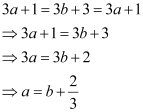
Therefore, the required relationship is given by,
![]()
Q18 :For what value of is the function defined by
continuous at x = 0? What about continuity at x= 1?
Answer :
The given function f is
If f is continuous at x= 0, then

Therefore, there is no value of λ for which fis continuous at x= 0
At x = 1,
f(1) = 4x + 1 = 4 × 1 + 1 = 5

Therefore, for any values of λ, f is continuous at x= 1
Q19 :Show that the function defined by![]() is discontinuous at all integral point. Here
is discontinuous at all integral point. Here![]() denotes the greatest integer less than or equal to x.
denotes the greatest integer less than or equal to x.
Answer :
The given function is![]()
It is evident that g is defined at all integral points.
Let n be an integer.
Then,![]()
The left hand limit of f at x = n is,
![]()
The right hand limit of f at x = n is,
![]()
It is observed that the left and right hand limits of f at x = n do not coincide.
Therefore, f is not continuous at x= n
Hence, g is discontinuous at all integral points.
Q20 :Is the function defined by![]() continuous at x = π?
continuous at x = π?
Answer :
The given function is![]()
It is evident that f is defined at x = π.
![]()

Therefore, the given function f is continuous at x = π
Q21 :Discuss the continuity of the following functions.
(a) f(x) = sin x + cos x
(b) f(x) = sin x – cos x
(c) f(x) = sin x x cos x
Answer :
It is known that if g and h are two continuous functions, then![]() are also continuous.
are also continuous.
It has to proved first that g(x) = sin x and h(x) = cos x are continuous functions.
Let g (x) = sin x
It is evident that g(x) = sin x is defined for every real number.
Let c be a real number. Put x= c + h
If x → c, then h → 0

Therefore, g is a continuous function.
Let h (x) = cos x
It is evident that h(x) = cos x is defined for every real number.
Let c be a real number. Put x= c + h
If x → c, then h → 0
h (c) = cos c

Therefore, h is a continuous function.
Therefore, it can be concluded that
(a) f(x) = g(x) + h(x) = sin x + cos x is a continuous function
(b) f(x) = g(x) – h (x) = sin x – cos x is a continuous function
(c) f(x) = g(x) × h (x) = sin x ×cos x is a continuous function
Q22 :Discuss the continuity of the cosine, cosecant, secant and cotangent functions,
Answer :
It is known that if g and h are two continuous functions, then

It has to be proved first that g(x) = sin x and h(x) = cos x are continuous functions.
Let g (x) = sin x
It is evident that g(x) = sin x is defined for every real number.
Let c be a real number. Put x= c+ h
If x![]() c, then h
c, then h
![]() 0
0

Therefore, g is a continuous function.
Let h(x) = cos x
It is evident that h(x) = cos xis defined for every real number.
Let c be a real number. Put x= c+ h
If x ® c, then h ® 0
h (c) = cos c

Therefore, h(x) = cos x is continuous function.
It can be concluded that,

Therefore, cosecant is continuous except at x = np, n î Z

Therefore, secant is continuous except at
![]()

Therefore, cotangent is continuous except at x = np, n î Z
Q23 :Find the points of discontinuity of f, where
Answer :
The given function f is
It is evident that fis defined at all points of the real line.
Let c be a real number.
Case I:

Therefore, f is continuous at all points x, such that x < 0
Case II:

Therefore, f is continuous
at all points x, such that x> 0
Case III:
![]()
The left hand limit of fat x = 0 is,
![]()
The right hand limit of fat x = 0 is,

Therefore, f is continuous at x= 0
From the above observations, it can be concluded that f is continuous at all points of the real line.
Thus, f has no point of discontinuity.
Q24 : Determine if f defined by
is a continuous function?
Answer :
The given function f is
It is evident that f is defined at all points of the real line.
Let c be a real number.
Case I:

Therefore, f is continuous at all points x ≠0
Case II:
![]()

![]()
Therefore, f is continuous at x= 0
From the above observations, it can be concluded that f is continuous at every point of the real line.
Thus, f is a continuous function.
Q25 :Examine the continuity of f, where f is defined by![]()
Answer :
The given function f is![]()
It is evident that f is defined at all points of the real line.
Let c be a real number.
Case I:

Therefore, f is continuous at all points x, such that x ≠0
Case II:
![]()

Therefore, f is continuous at x= 0
From the above observations, it can be concluded thatf is continuous at every point of the real line.
Thus, f is a continuous function.
Q26 :Find the values of k so that the function f is continuous at the indicated point.
Answer :
The given function f is
The given function f is continuous at![]() , if f is defined at
, if f is defined at
![]() and if the value of the f at
and if the value of the f at
![]() equals the limit of f at
equals the limit of f at
![]() .
.
It is evident that f is defined at![]() and
and
![]()

Therefore, the required value of k is 6.
Q27 :Find the values of k so that the function fis continuous at the indicated point.
Answer :
The given function is
The given function fis continuous at x= 2, if fis defined at x= 2 and if the value of fat x = 2 equals the limit of fat x = 2
It is evident that f is defined at x= 2 and![]()

Therefore, the required value of.
Q28 :Find the values of k so that the function fis continuous at the indicated point.![]()
Answer :
The given function is![]()
The given function fis continuous at x= p, if fis defined at x= p and if the value of fat x= pequals the limit of fat x= p
It is evident that f is defined at x= p and![]()

Therefore, the required value of![]()
Q29 :Find the values of k so that the function fis continuous at the indicated point.![]()
Answer :
The given function f is![]()
The given function fis continuous at x= 5, if fis defined at x= 5 and if the value of fat x = 5 equals the limit of fat x = 5
It is evident that f is defined at x= 5 and
![]()

Therefore, the required value of![]()
Q30 :Find the values of aand b such that the function defined by
is a continuous function.
Answer :
The given function f is
It is evident that the given function fis defined at all points of the real line.
If fis a continuous function, then fis continuous at all real numbers.
In particular, fis continuous at x = 2 and x = 10
Since f is continuous at x = 2, we obtain

Since f is continuous at x = 10, we obtain

On subtracting equation (1) from equation (2), we obtain
8a= 16
⇒ a= 2
By putting a= 2 in equation (1), we obtain
2 ×2 + b = 5
⇒ 4 + b = 5
⇒ b= 1
Therefore, the values of aand b for which f is a continuous function are 2 and 1 respectively.
Q31 :Show that the function defined by f (x) = cos (x2) is a continuous function.
Answer :
The given function is f (x) = cos (x2)
This function fis defined for every real number and fcan be written as the composition of two functions as,
f= g o h, where g(x) = cos x and h(x) = x2![]()
It has to be first proved that g (x) = cos xand h (x) = x2 are continuous functions.
It is evident that gis defined for every real number.
Let c be a real number.
Then, g (c) = cos c
Therefore, g (x) = cos x is continuous function.
h(x) = x2
Clearly, h is defined for every real number.
Let k be a real number, then h (k) = k2
Therefore, h is a continuous function.
It is known that for real valued functions g and h,such that (g o h) is defined at c, if g is continuous at c and if f is continuous at g (c), then (f o g) is continuous at c.
Therefore,![]() is a continuous function.
is a continuous function.
Q32 :Show that the function defined by ![]() is a continuous function.
is a continuous function.
Answer :
The given function is![]()
This function fis defined for every real number and fcan be written as the composition of two functions as,
f= g o h, where![]()
![]()
It has to be first proved that![]() are continuous functions.
are continuous functions.
Clearly, g is defined for all real numbers.
Let c be a real number.
Case I:
Therefore, g is continuous at all points x, such that x < 0
Case II:
Therefore, g is continuous at all points x, such that x> 0
Case III:![]()

Therefore, g is continuous at x= 0
From the above three observations, it can be concluded that gis continuous at all points.
h (x) = cos x
It is evident that h(x) = cos x is defined for every real number.
Let c be a real number. Put x= c + h
If x → c, then h →0
h (c) = cos c
Therefore, h (x) = cos x is a continuous function.
It is known that for real valued functions g and h,such that (g o h) is defined at c, if g is continuous at c and if f is continuous at g (c), then (f o g) is continuous at c.
Therefore, ![]() is a continuous function.
is a continuous function.
Q33 :Examine that![]() is a continuous function.
is a continuous function.
Answer :![]()
This function fis defined for every real number and fcan be written as the composition of two functions as,
f= g o h, where![]()
![]()
It has to be proved first that ![]() are continuous functions.
are continuous functions.
Clearly, g is defined for all real numbers.
Let c be a real number.
Case I:
Therefore, g is continuous at all points x, such that x < 0
Case II: 
Therefore, g is continuous at all points x, such that x> 0
Case III:![]()

Therefore, g is continuous at x= 0
From the above three observations, it can be concluded that gis continuous at all points.
h (x) = sin x
It is evident that h(x) = sinx is defined for every real number.
Let c be a real number. Put x= c + k
If x→ c, then k →0
h (c) = sin c
Therefore, h is a continuous function.
It is known that for real valued functions g and h,such that (g o h) is defined at c, if g is continuous at c and if f is continuous at g (c), then (f o g) is continuous at c.
Therefore, ![]() is a continuous function.
is a continuous function.
Q34 :Find all the points of discontinuity of f defined by![]() .
.
Answer :
The given function is![]()
The two functions, gand h, are defined as![]()
Then, f = g – h
The continuity of g and h is examined first.

Clearly, g is defined for all real numbers.
Let c be a real number.
Case I:
Therefore, g is continuous at all points x, such that x < 0
Case II: 
Therefore, g is continuous at all points x, such that x> 0
Case III:![]()

Therefore, g is continuous at x= 0
From the above three observations, it can be concluded that gis continuous at all points.
Clearly, h is defined for every real number.
Let c be a real number.
Case I:
Therefore, h is continuous at all points x, such that x < – 1
Case II:
Therefore, h is
continuous at all points x, such that x> – 1
Case III:![]()
![]()

Therefore, h is continuous at x= – 1
From the above three observations, it can be concluded that his continuous at all points of the real line.
Exercise 5.2 : Solutions of Questions on Page Number : 166
Q1 :Differentiate the functions with respect to x.![]()
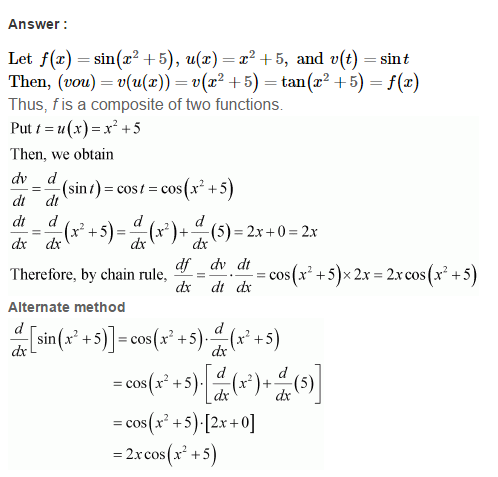
Q2 :Differentiate the functions with respect to x.![]()
Answer :

Thus, f is a composite function of two functions.
Put t = u (x) = sin x
By chain rule,![]()
Alternate method![]()
Q3 :Differentiate the functions with respect to x.![]()
Answer :
Thus, f is a composite function of two functions, u and v.
Put t = u (x) = ax + b
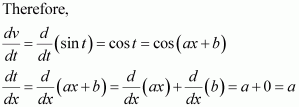
Hence, by chain rule, we obtain
![]()
Alternate method

Q4 :Differentiate the functions with respect to x.![]()
Answer :
Thus, f is a composite function of three functions, u, v, and w.
![]()

Hence, by chain rule, we obtain

Alternate method

Q5 :Differentiate the functions with respect to x.![]()
Answer :
The given function
![]() is, where g (x) = sin (ax + b) and
is, where g (x) = sin (ax + b) and
h (x) = cos (cx + d)
![]()
∴ g is a composite function of two functions, u and v.

Therefore, by chain rule, we obtain
∴h is a composite function of two functions, p and q.
Put y = p (x) = cx + d
 Therefor, by chain rule, we obtain
Therefor, by chain rule, we obtain
![]()

Q6 :Differentiate the functions with respect to x.![]()
Answer :
The given function is.
![]()

Q7 :Differentiate the functions with respect to x.![]()
Answer :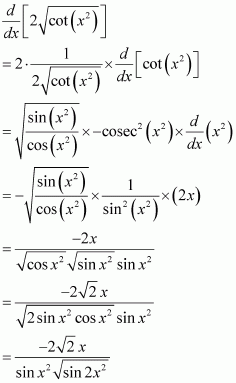
Q8 :Differentiate the functions with respect to x.![]()
Answer :
Clearly, f is a composite function of two functions, u and v, such that![]()

By using chain rule, we obtain
Alternate method
Q9 :Prove that the function f given by![]()
is not differentiable at x = 1.
Answer :
The given function is
![]()
It is known that a function f is differentiable at a point x = c in its domain if both
![]()
are finite and equal.
To check the differentiability of the given function at x = 1,
consider the left hand limit of f at x = 1


Since the left and right hand limits of f at x = 1 are not equal, f is not differentiable at x = 1
Q10 :Prove that the greatest integer function defined by ![]() is not
is not
differentiable at x = 1 and x = 2.
Answer :
The given function f is
![]()
It is known that a function f is differentiable at a point x = c in its domain if both
![]()
are finite and equal.
To check the differentiability of the given function at x = 1, consider the left hand limit of f at x = 1


Since the left and right hand limits of f at x = 1 are not equal, f is not differentiable at
x = 1
To check the differentiability of the given function at x = 2, consider the left hand limit
of f at x = 2


Since the left and right hand limits of f at x = 2 are not equal, f is not differentiable at x = 2
Exercise 5.3 : Solutions of Questions on Page Number : 169
Q1 :Find :![]()
![]()
Answer :
The given relationship is![]()
Differentiating this relationship with respect to x, we obtain

Q2 :Find :![]()
![]()
Answer :
The given relationship is![]() Differentiating this relationship with respect to x, we obtain
Differentiating this relationship with respect to x, we obtain
![]()
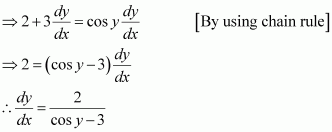
Q3 :Find :![]()
![]()
Answer :
The given relationship is![]()
Differentiating this relationship with respect to x, we obtain

Using chain rule, we obtain
![]() and
and
![]()
From (1) and (2), we obtain
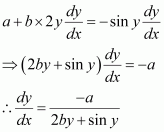
Q4 :Find :![]()
![]()
Answer :
The given relationship is
![]()
Differentiating this relationship with respect to x, we obtain

Q5 :Find :![]()
![]()
Answer :
The given relationship is
![]()
Differentiating this relationship with respect to x, we obtain
![]()
![]() [Derivative of constant function is 0]
[Derivative of constant function is 0]

Q6 :Find :![]()
![]()
Answer :
The given relationship is![]() Differentiating this relationship with respect to x, we obtain
Differentiating this relationship with respect to x, we obtain

Q7 :Find :![]()
![]()
Answer :
The given relationship is![]()
Differentiating this relationship with respect to x, we obtain

Using chain rule, we obtain

From (1), (2), and (3), we obtain

Q8 :Find :![]()
![]()
Answer :
The given relationship is![]()
Differentiating this relationship with respect to x, we obtain

Q9 :Find :![]()
![]()
Answer :
The given relationship is![]()

Differentiating this relationship with respect to x, we obtain

The function,![]() , is of the form of
, is of the form of![]() .
.
Therefore, by quotient rule, we obtain
Also,![]()

From (1), (2), and (3), we obtain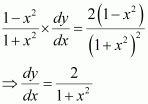
Q10 :Find :![]()

Answer :
The given relationship is

It is known that,
Comparing equations (1) and (2), we obtain
![]()
Differentiating this relationship with respect to x, we obtain

Q11 :Find :![]()

Answer :
The given relationship is,
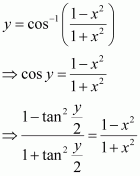
On comparing L.H.S. and R.H.S. of the above relationship, we obtain
![]()
Differentiating this relationship with respect to x, we obtain.

Q12 :Find :![]()

Answer :
The given relationship is


![]()
Differentiating this relationship with respect to x, we obtain

Using chain rule, we obtain


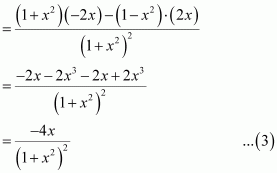
From (1), (2), and (3), we obtain

Alternate method

⇒![]()


Differentiating this relationship with respect to x, we obtain

Q13 :Find :![]()
![]()
Answer :
The given relationship is
![]()

Differentiating this relationship with respect to x, we obtain


Q14 :![]()
![]()
Find :
Answer :
The given relationship is
![]()

Differentiating this relationship with respect to x, we obtain
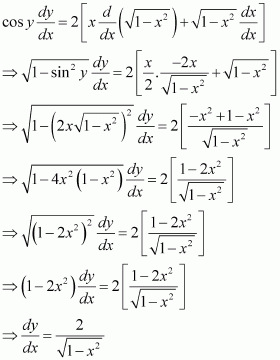
Q15 :Find :![]()
![]()
Answer :
The given relationship is
![]()
![]()

Differentiating this relationship with respect to x, we obtain

Exercise 5.4 : Solutions of Questions on Page Number : 174
Q1 :Differentiate the following w.r.t. x:![]()
Answer :
Let![]()
By using the quotient rule, we obtain

Q2 :Differentiate the following w.r.t. x:![]()
Answer :
Let
![]()
By using the chain rule, we obtain

Q3 :Differentiate the following w.r.t. x:![]()
Answer :
Let![]()
By using the chain rule, we obtain

Q4 :Differentiate the following w.r.t. x:![]()
Answer :
Let![]()
By using the chain rule, we obtain

Q5 :Differentiate the following w.r.t. x:![]()
Answer :
Let![]()
By using the chain rule, we obtain

Q6 :Differentiate the following w.r.t. x:![]()
Answer :

Q7 :Differentiate the following w.r.t. x:
![]()
Answer :
Let![]()
Then,![]()
By differentiating this relationship with respect to x, we obtain

Q8 :Differentiate the following w.r.t. x:![]()
Answer :
Let![]()
By using the chain rule, we obtain

![]() , x > 1
, x > 1
Q9 :Differentiate the following w.r.t. x:![]()
Answer :
Let![]()
By using the quotient rule, we obtain

Q10 :Differentiate the following w.r.t. x:![]()
Answer :
Let![]()
By using the chain rule, we obtain

Exercise 5.5 : Solutions of Questions on Page Number : 178
Q1 :Differentiate the function with respect to x.![]()
Answer :![]()
Taking logarithm on both the sides, we obtain
Differentiating both sides with respect to x, we obtain

Q2 :Differentiate the function with respect to x.

Answer :

Taking logarithm on both the sides, we obtain

Differentiating both sides with respect to x, we obtain

Q3 :Differentiate the function with respect to x.![]()
Answer :![]()
Taking logarithm on both the sides, we obtain![]()
Differentiating both sides with respect to x, we obtain

Q4 :Differentiate the function with respect to x.![]()
Answer :
u = xx
Taking logarithm on both the sides, we obtain![]()
Differentiating both sides with respect to x, we obtain

v = 2sin x
Taking logarithm on both the sides with respect to x, we obtain![]()
Differentiating both sides with respect to x, we obtain

![]()
Q5 :Differentiate the function with respect to x.![]()
Answer :![]()
Taking logarithm on both the sides, we obtain

Differentiating both sides with respect to x, we obtain
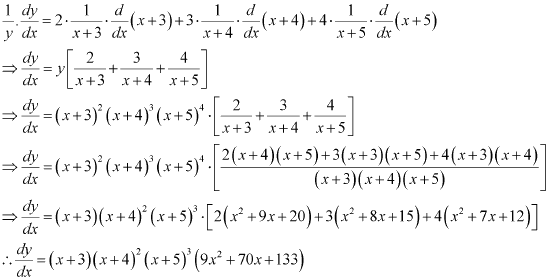
Q6 :Differentiate the function with respect to x.![]()
Answer :![]()
Taking logarithm on both the sides, we obtain

Differentiating both sides with respect to x, we obtain
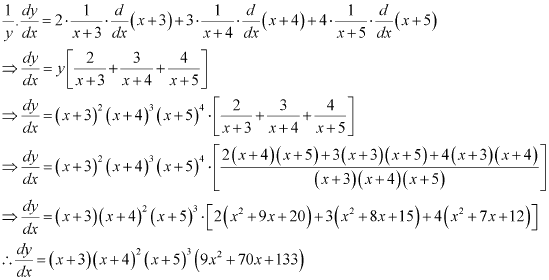
Q7 :Differentiate the function with respect to x.![]()
Answer :
![]()
u = (log x)x

Differentiating both sides with respect to x, we obtain

![]()

Differentiating both sides with respect to x, we obtain

Therefore, from (1), (2), and (3), we obtain
![]()
Q8 :Differentiate the function with respect to x.![]()
Answer :

Differentiating both sides with respect to x, we obtain

Therefore, from (1), (2), and (3), we obtain
![]()
Q9 :Differentiate the function with respect to x.![]()
Answer :

Differentiating both sides with respect to x, we obtain


Differentiating both sides with respect to x, we obtain

From (1), (2), and (3), we obtain
![]()
Q10 :Differentiate the function with respect to x.
![]()
Answer :

Differentiating both sides with respect to x, we obtain


Differentiating both sides with respect to x, we obtain

From (1), (2), and (3), we obtain

Q11 :Differentiate the function with respect to x.![]()
Answer :

Differentiating both sides with respect to x, we obtain


Differentiating both sides with respect to x, we obtain

From (1), (2), and (3), we obtain

Q12 :Find ![]() of function.
of function.![]()
Answer :
The given function is![]()
Let xy = u and yx = v
Then, the function becomes u + v = 1
![]()

Differentiating both sides with respect to x, we obtain


Differentiating both sides with respect to x, we obtain

From (1), (2), and (3), we obtain

Q13 :Find![]() of function.
of function.![]()
Answer :
The given function is![]()
Taking logarithm on both the sides, we obtain
![]()
Differentiating both sides with respect to x, we obtain

Q14 :Find ![]() of function.
of function.
![]()
Answer :
The given function is![]()
Taking logarithm on both the sides, we obtain
![]()
Differentiating both sides, we obtain

Q15 :Find ![]() of function.
of function.![]()
Answer :
The given function is![]()
Taking logarithm on both the sides, we obtain

Differentiating both sides with respect to x, we obtain

Q16 :Find the derivative of the function given by
![]() and hence find
and hence find
![]() .
.
Answer :
The given relationship is
![]()
Taking logarithm on both the sides, we obtain
![]()
Differentiating both sides with respect to x, we obtain

Q17 :Differentiate![]() in three ways mentioned below
in three ways mentioned below
(i) By using product rule.
(ii) By expanding the product to obtain a single polynomial.
(iii By logarithmic differentiation.
Do they all give the same answer?
Answer :
![]()
(i)
(ii)
(iii)![]()
Taking logarithm on both the sides, we obtain
![]()
Differentiating both sides with respect to x, we obtain

From the above three observations, it can be concluded that all the results of are same.
Q18 :If u, v and w are functions of x, then show that![]()
in two ways-first by repeated application of product rule, second by logarithmic differentiation.
Answer :
Let![]()
By applying product rule, we obtain

By taking logarithm on both sides of the equation, we obtain
![]()
Differentiating both sides with respect to x, we obtain

Exercise 5.6 : Solutions of Questions on Page Number : 181
Q1 :If x and y are connected parametrically by the equation, without eliminating the parameter, find![]() .
.
![]()
Answer :
The given equations are
![]()

Q2 :If x and y are connected parametrically by the equation, without eliminating the parameter, find![]() .
.
x = a cos θ, y = b cos θ
Answer :
The given equations arex = a cos θ and y = b cos θ
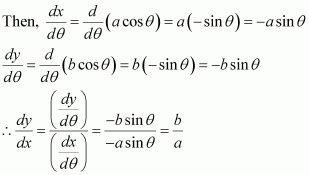
Q3 :If x and y are connected parametrically by the equation, without eliminating the parameter, find![]() .
.
x = sin t, y = cos 2t
Answer :
The given equations are x = sin t and y = cos 2t

Q4 :If x and y are connected parametrically by the equation, without eliminating the parameter, find![]() .
.![]()
Answer :
The given equations are![]()

Q5 :If x and y are connected parametrically by the equation, without eliminating the parameter, find![]() .
.![]()
Answer :
The given equations are![]()

Q6 :If x and y are connected parametrically by the equation, without eliminating the parameter, find![]() .
.![]()
Answer :
The given equations are![]()

Q7 :If x and y are connected parametrically by the equation, without eliminating the parameter, find![]() .
.![]()
Answer :
The given equations are![]()



Q8 :If x and y are connected parametrically by the equation, without eliminating the parameter, find![]() .
.![]()
Answer :
The given equations are![]()


Q9 :If x and y are connected parametrically by the equation, without eliminating the parameter, find![]() .
.![]()
Answer :
The given equations are![]()
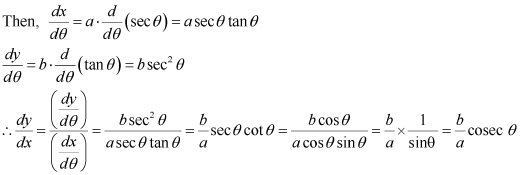
Q10 :If x and y are connected parametrically by the equation, without eliminating the parameter, find![]() .
.![]()
Answer :
The given equations are![]()

Q11 :If![]()
Answer :
The given equations are![]()



Hence, proved.
Exercise 5.7 : Solutions of Questions on Page Number : 183
Q1 :Find the second order derivatives of the function.![]()
Answer :
Let![]()
Then,
Q2 :Find the second order derivatives of the function.![]()
Answer :
Let![]()
Then,

Q3 :Find the second order derivatives of the function.![]()
Answer :
Let![]()
Then,

Q4 :Find the second order derivatives of the function.![]()
Answer :
Let![]()
Then,
Q5 :Find the second order derivatives of the function.![]()
Answer :
Let![]()
Then,

Q6 :Find the second order derivatives of the function.![]()
Answer :
Let![]()

Then,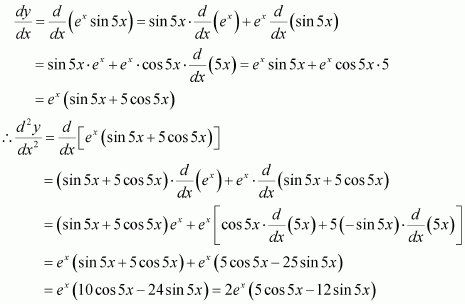
Q7 :Find the second order derivatives of the function.![]()
Answer :
Let![]()
Then,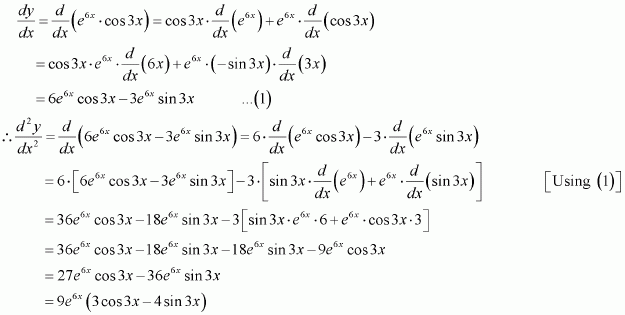
Q8 :Find the second order derivatives of the function.![]()
Answer :
Let![]()
Then,
Q9 :Find the second order derivatives of the function.![]()
Answer :
Let![]()
Then,
Q10 :Find the second order derivatives of the function.![]()
Answer :
Let![]()
Then,
Q11 :If![]() , prove that
, prove that![]()
Answer :
It is given that,![]()
Then,
Hence, proved.
Q12 :If![]() find
find![]() in terms of y alone.
in terms of y alone.
Answer :
It is given that,![]()
Then,
Q13 :If![]() , show that
, show that![]()
Answer :
It is given that,![]()
Then,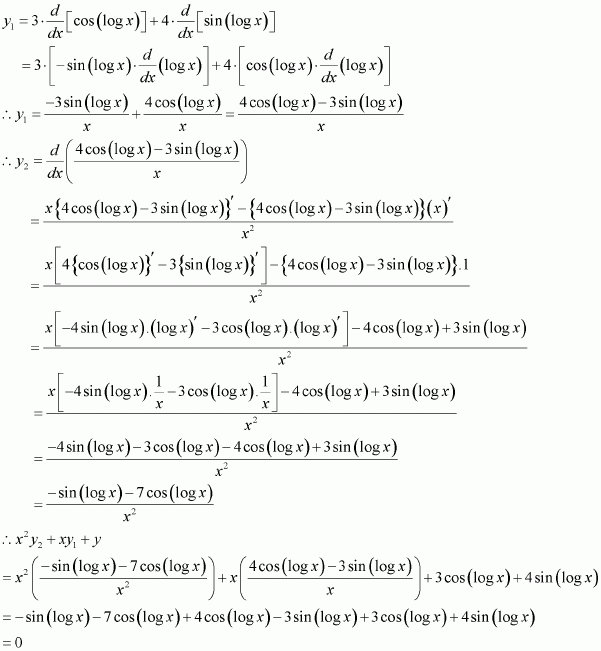
Hence, proved.
Q14 :If![]() show that
show that![]()
Answer :
It is given that,![]()
Then,
Hence, proved.
Q15 :If![]() , show that
, show that![]()
Answer :
It is given that,![]()
Then,
Hence, proved.
Q16 :If![]() , show that
, show that![]()
Answer :
The given relationship is![]()

Taking logarithm on both the sides, we obtain![]()
Differentiating this relationship with respect to x, we obtain
Hence, proved.
Q17 :If![]() , show that
, show that![]()
Answer :
The given relationship is![]()
Then,
Hence, proved.
Exercise 5.8 : Solutions of Questions on Page Number : 186
Q1 :Verify Rolle’s Theorem for the function![]()
![]()
Answer :
The given function,![]() , being a polynomial function, is continuous in [ – 4, 2] and is differentiable in ( – 4, 2).
, being a polynomial function, is continuous in [ – 4, 2] and is differentiable in ( – 4, 2).
∴ f ( – 4) = f (2) = 0
⇒ The value of f (x) at – 4 and 2 coincides.
Rolle’s Theorem states that there is a point c ∈ ( – 4, 2) such that![]()

Hence, Rolle’s Theorem is verified for the given function.
Q2 :Examine if Rolle’s Theorem is applicable to any of the following functions. Can you say some thing about the converse of Rolle’s Theorem from these examples?
(i)![]()
(ii)![]()
(iii)![]()
Answer :
By Rolle’s Theorem, for a function,![]() if
if
(a) f is continuous on [a, b]
(b) f is differentiable on (a, b)
(c) f (a) = f (b)
then, there exists some c ∈ (a, b) such that![]()
Therefore, Rolle’s Theorem is not applicable to those functions that do not satisfy any of the three conditions of the hypothesis.
(i)![]()
It is evident that the given function f (x) is not continuous at every integral point.
In particular, f(x) is not continuous at x = 5 and x = 9
⇒ f (x) is not continuous in [5, 9].
The differentiability of f in (5, 9) is checked as follows.
Let n be an integer such that n ∈ (5, 9).
Since the left and right hand limits of f at x = n are not equal, f is not differentiable at x = n
∴f is not differentiable in (5, 9).
It is observed that f does not satisfy all the conditions of the hypothesis of Rolle’s Theorem.
Hence, Rolle’s Theorem is not applicable for.![]()
(ii)![]() It is evident that the given function f (x) is not continuous at every integral point.
It is evident that the given function f (x) is not continuous at every integral point.
In particular, f(x) is not continuous at x = – 2 and x = 2
⇒ f (x) is not continuous in [ – 2, 2].
The differentiability of f in ( – 2, 2) is checked as follows.
Let n be an integer such that n ∈ ( – 2, 2).
Since the left and right hand limits of f at x = n are not equal, f is not differentiable at x = n∴f is not differentiable in ( – 2, 2).
It is observed that f does not satisfy all the conditions of the hypothesis of Rolle’s Theorem.
Hence, Rolle’s Theorem is not applicable for.![]()
(iii)![]()
It is evident that f, being a polynomial function, is continuous in [1, 2] and is differentiable in (1, 2).
∴f (1) ≠ f (2)
It is observed that f does not satisfy a condition of the hypothesis of Rolle’s Theorem.
Hence, Rolle’s Theorem is not applicable for![]() .
.
Q3 :If ![]() is a differentiable function and if
is a differentiable function and if ![]() does not vanish anywhere, then prove that
does not vanish anywhere, then prove that![]() .
.
Answer :
It is given that is a differentiable function![]() .
.
Since every differentiable function is a continuous function, we obtain
(a) f is continuous on [ – 5, 5].
(b) f is differentiable on ( – 5, 5).
Therefore, by the Mean Value Theorem, there exists c ∈ ( – 5, 5) such that
It is also given that does not vanish anywhere.
Hence, proved.
Q4 :Verify Mean Value Theorem, if![]() in the interval
in the interval![]() , where
, where ![]() and
and![]() .
.
Answer :
The given function is![]()
f, being a polynomial function, is continuous in [1, 4] and is differentiable in (1, 4) whose derivative is 2x – 4.
Mean Value Theorem states that there is a point c ∈ (1, 4) such that
Hence, Mean Value Theorem is verified for the given function.
Q5 :Verify Mean Value Theorem, if ![]() in the interval [a, b], where a = 1 and b = 3. Find all
in the interval [a, b], where a = 1 and b = 3. Find all ![]() for which
for which![]()
Answer :
The given function f is![]()
f, being a polynomial function, is continuous in [1, 3] and is differentiable in (1, 3) whose derivative is 3×2 – 10x – 3.
Mean Value Theorem states that there exist a point c ∈ (1, 3) such that
Hence, Mean Value Theorem is verified for the given function ![]() and
and![]() is the only point for which
is the only point for which
Q6 :Examine the applicability of Mean Value Theorem for all three functions given in the above exercise 2.
Answer :
Mean Value Theorem states that for a function, ![]() if
if
(a) f is continuous on [a, b]
(b) f is differentiable on (a, b)
then, there exists some c ∈ (a, b) such that![]()
Therefore, Mean Value Theorem is not applicable to those functions that do not satisfy any of the two conditions of the hypothesis.
(i)![]()
It is evident that the given function f (x) is not continuous at every integral point.
In particular, f(x) is not continuous at x = 5 and x = 9
⇒ f (x) is not continuous in [5, 9].
The differentiability of f in (5, 9) is checked as follows.
Let n be an integer such that n ∈ (5, 9).
Since the left and right hand limits of f at x = n are not equal, f is not differentiable at x = n
∴f is not differentiable in (5, 9).
It is observed that f does not satisfy all the conditions of the hypothesis of Mean Value Theorem.
Hence, Mean Value Theorem is not applicable for ![]() .
.
(ii)![]()
It is evident that the given function f (x) is not continuous at every integral point.
In particular, f(x) is not continuous at x = – 2 and x = 2
⇒ f (x) is not continuous in [ – 2, 2].
The differentiability of f in ( – 2, 2) is checked as follows.
Let n be an integer such that n ∈ ( – 2, 2).
Since the left and right hand limits of f at x = n are not equal, f is not differentiable at x = n
∴f is not differentiable in ( – 2, 2).
It is observed that f does not satisfy all the conditions of the hypothesis of Mean Value Theorem.
Hence, Mean Value Theorem is not applicable for![]() .
.
(iii)![]()
It is evident that f, being a polynomial function, is continuous in [1, 2] and is differentiable in (1, 2).
It is observed that f satisfies all the conditions of the hypothesis of Mean Value Theorem.
Hence, Mean Value Theorem is applicable for![]() .
.
It can be proved as follows.

Exercise Miscellaneous : Solutions of Questions on Page Number : 191
Q1 :![]()
Answer :![]()
Using chain rule, we obtain
Q2 :![]()
Answer :
Q3 :![]()
![]()
Taking logarithm on both the sides, we obtain![]()
Differentiating both sides with respect to x, we obtain
Q4 :![]()
Answer :![]()
Using chain rule, we obtain
Q5 :
Answer :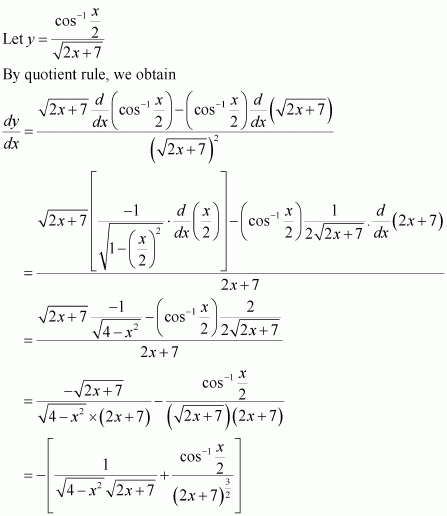
Q6 :
Answer :
Therefore, equation (1) becomes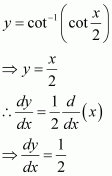
Q7 :![]()
Answer :![]()
Taking logarithm on both the sides, we obtain![]()
Differentiating both sides with respect to x, we obtain
Q8 :![]() , for some constant a and b.
, for some constant a and b.
Answer :![]()
By using chain rule, we obtain
Q9 :![]()
Answere :![]()
Taking logarithm on both the sides, we obtain
Differentiating both sides with respect to x, we obtain
Q10 :![]()
, for some fixed ![]() and
and![]()
Answer :
Differentiating both sides with respect to x, we obtain

Differentiating both sides with respect to x, we obtain
s= aa
Since a is constant, aais also a constant.
∴![]()
From (1), (2), (3), (4), and (5), we obtain
Q11 :![]()
, for
Answer :
Differentiating both sides with respect to x,we obtain
Differentiating with respect to x, we obtain
Also,
Differentiating both sides with respect to x, we obtain
Substituting the expressions![]() of in equation (1), we obtain
of in equation (1), we obtain
Q12 :Find![]() , if
, if![]()
Answer :
Q13 :Find![]() , if
, if![]()
Answer :
Q14 :If![]() , for, – 1 < x<1, prove that
, for, – 1 < x<1, prove that![]()
Answer :
It is given that,![]()

Differentiating both sides with respect to x, we obtain
Hence, proved.
Q15 :If![]() , for some
, for some![]() prove that
prove that
is a constant independent of a and b.
Answer :
It is given that,![]()
Differentiating both sides with respect to x, we obtain

Hence, proved.
Q16 :If![]() with
with![]() prove that
prove that![]()
Answer :

Hence, proved.
Q17 :If ![]() and
and![]() , find
, find![]()
Answer :

Q18 :If![]() , show that
, show that![]() exists for all real x, and find it.
exists for all real x, and find it.
Answer :
It is known that,![]()
Therefore, when x ≥0,![]()
In this case![]() , and hence,
, and hence,![]()
When x < 0,![]()
In this case, ![]() and hence,
and hence,![]()
Thus, for![]() ,
,![]() exists for all real xand is given by,
exists for all real xand is given by,![]()
Q19 :Using mathematical induction prove that![]() for all positive integers n.
for all positive integers n.
Answer :![]()
For n= 1,![]()
∴P(n) is true for n= 1
Let P(k) is true for some positive integer k.
That is,![]()
It has to be proved that P(k+ 1) is also true.
Thus, P(k + 1) is true whenever P (k) is true.
Therefore, by the principle of mathematical induction, the statement P(n) is true for every positive integer n.
Hence, proved.
Q20 :Using the fact that sin (A + B) = sin Acos B + cos A sin B and the differentiation, obtain the sum formula for cosines.
Answer :![]()
Differentiating both sides with respect to x, we obtain
Q21 : Does there exist a function which is continuous everywhere but not differentiable at exactly two points? Justify your answer ?
Answer :

Q22 :If , prove that
, prove that
Answer :
Thus,
Q23 :If![]() , show that
, show that![]()
Answer :
It is given that,![]()

